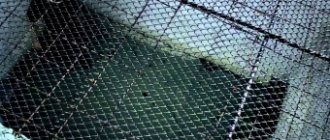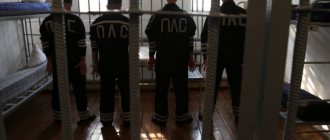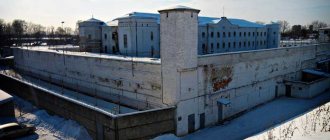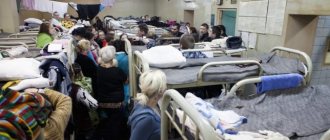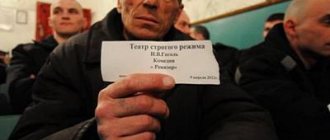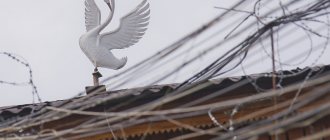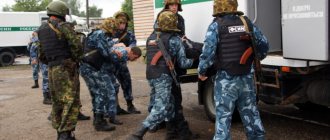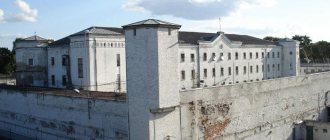"White Swan"
The official name is PKU OIK-2 OUCD GUFSIN of Russia for the Perm Territory .
Popularly known as the "White Swan". Located in the city of Solikamsk (Perm region). Built in 1938. Designed to accommodate 962 people. The name “White Swan” was invented by the convicts themselves. Here, in their opinion, many have their last berth, their last swan song. Later, local craftsmen from among the prisoners themselves depicted a swan in a mosaic, as well as in the form of a weather vane on the roof.
Currently, there are actually two colonies: strict regime IK-1 and special regime IK-2 for persons sentenced to life imprisonment, which is located inside IK-1. At the moment, those convicted of especially serious crimes are serving their sentences in the colony (how is a colony different from a prison?). These are serial and mass murderers, rapists, gang members, leaders of organized crime groups, and terrorists. Currently there are about 300 of them.
The conditions of detention of convicts comply with international standards and Russian legislation. There are from one to three people in one cell (what do cells look like in Russian prisons?). You are allowed to read literature, make purchases in the prison store, and correspond. All other contacts with the outside world are severely limited.
During the first 10 years of detention, visits with relatives are prohibited, correspondence is no more than one letter per year, and 24-hour video surveillance is conducted.
If the prisoner does not have any violations of the regime, the conditions of detention are slightly relaxed. Throughout the colony, prisoners move in a pose bent 90 degrees forward with their arms raised behind their backs (the so-called “swan pose,” which is also how the colony got its unofficial name).
During Soviet times, the colony was actively used as a tool for the re-education of thieves in law. According to unverified data, about 130 criminal authorities were “uncrowned” in the White Swan. The most famous thief who found himself within the walls of the colony was Vladimir Babushkin, known as Vasya the Diamond, who was imprisoned there until his death in 1985.
Among other famous prisoners, it is worth noting another thief in law Aslan Usoyan (Ded Khasan), who served part of his 15-year sentence here, serial killer Sergei Ryakhovsky, who died within these walls in 2005, and a famous political figure in St. Petersburg, A. Sobchak's associate Yuri Shutov, convicted as part of an organized criminal group for organizing contract killings.
But the most famous prisoner of the “White Swan” is the Chechen field commander and terrorist Salman Raduev , “famous” for the seizure of a hospital in the city of Kizlyar, who died in prison in 2002.
Currently, among other prisoners in the colony are serving their sentences:
- Dmitry Vinogradov is a mass murderer who shot six colleagues in 2012;
- Nikolai Dudin - serial killer from Ivanovo;
- Dmitry Karimov is a serial killer from Yekaterinburg.
We invite you to watch a video about the White Swan prison:
Orders before 2003
Until 2003, women could be sentenced to serve their sentences under strict security conditions. Conditions in such places were created without taking into account the physiological as well as psychological needs of the female body.
After a woman served her sentence in such conditions, she became completely unsuitable for life in the wild.
Therefore, there has gradually become a need to make changes to the regime of stay of women who have committed serious crimes. Because they differ from men in physiological needs and social adaptation.
At the beginning of 2003, more than three hundred amendments were made to the PEC and the Criminal Code. With amendments in 2003, maximum security colonies for women were completely abolished. In addition, the number of visits was increased, as were the chances of being released from prison on parole.
With impeccable behavior, women have a chance to get a date outside the correctional facility.
At first, the practice of using meetings outside the zone was indeed used, but this practice quickly ceased.
"Vologda nickel"
The official name is FKU IK-5 of the Federal Penitentiary Service of Russia for the Vologda Region (OE-256/5). Also known as the "Vologda nickel". Located in the former Kirillo-Novoezersky monastery on Ognenny Island, on Lake Novy near the city of Belozersk, Vologda region. The prison has a capacity of 505 places, including a special security section for 55 places . There are currently 192 people in the colony.
Founded within the walls of the Kirillo-Novoezersky Monastery, erected in 1517. After the October Revolution, it was rebuilt into a prison for “enemies of the revolution” and was used to hold political prisoners until the death of Joseph Stalin. After 1953, especially dangerous criminals convicted of banditry and murder were imprisoned there. Since 1997, the Vologda Pyatak has exclusively housed those sentenced to life imprisonment.
The IK-5 regime is considered one of the toughest in the Russian correctional system. Prisoners are kept in cells of two, they always wear standard clothing, and any contact between prisoners from different cells is prohibited. All actions are performed only on command and with the permission of the supervisor ; any event is carried out under the watchful supervision of at least three employees.
Mass events (amateur concerts, sports competitions, film screenings) are prohibited. Convicts are allowed only short-term visits lasting a few hours. While in their cells, prisoners are not allowed to lie down or sit on their beds during the day.
Every time they leave a cell, a thorough search is carried out, both of the prisoners themselves and their cells. Prisoners move around the colony in handcuffs, leaning forward.
A distinctive feature of the Vologda Pyatak is its location on an island in the middle of the lake. Perhaps for this reason, in the entire history of the prison, not a single escape was recorded from it. Unlike the White Swan, the Vologda Pyatak was never used as a means of re-educating thieves in law. If this category of citizens got there, it was extremely rare. Only in the 1990s, after the announcement of a moratorium on the death penalty, criminals sentenced to life imprisonment began to be taken there.
Currently, members and leaders of organized crime groups, serial killers, and terrorists are serving their sentences in the colony. Among the most famous:
- Lom-Ali Gaitukaev is a Chechen businessman, the organizer of the murder of journalist Anna Politkovskaya, who at the time of the verdict was already serving a long prison sentence for other crimes;
- Sergei Pantyukhov – serial killer;
- Arasul Khubiev – organizer of the terrorist attack in Mineralnye Vody in 2001;
- Yusup Yunusov is one of the organizers of the explosion of the Government House in Grozny in 2002.
IK-5 was reflected in cinema. It is from its walls that Vasily Shukshin’s hero emerges in the film “Kalina Krasnaya”.
We invite you to watch a video about the Vologda Pyatak prison:
From Pugachev to Korolev, famous Butyrtsy
The most famous prison also hosted prisoners of appropriate status. A peasant revolt led by Emelyan Pugachev that broke out at the end of the 18th century was brutally suppressed. The rioters were shackled and thrown into damp dungeons. Emelyan Pugachev was transported to Butyrka in a cage and chained to a wall in one of the towers. Since then it has been named after him - Pugachevskaya.
In subsequent centuries, the revolutionary Nikolai Bauman, the legendary lieutenant Schmidt, the military leader Voroshilov, the founder of the Cheka Dzerzhinsky, the anarchist Makhno, the poet Osip Mandelstam, the singer Lydia Ruslanova, the actresses Zoya Fedorova and Tatyana Okunevskaya followed in Pugachev’s footsteps.
Actress Tatyana Okunevskaya. Source: wikimedia.org
The founder of the Russian cosmonautics, Sergei Korolev, was also imprisoned in Butyrka; his jaw was broken during another interrogation here. According to rumors, this is why the General Designer later died during a planned operation.
"Mordovian zone" or "Unit"
The official name is FKU IK-1 OUCD GUFSIN of Russia for the Republic of Mordovia (ZH-385/1). Also known as the "Mordovian zone" or "Unit". Located in Sosnovka, Republic of Mordovia. The prison was opened in 1931 and has a capacity of 1005 places (what other prisons are there in the Russian Federation?).
It contains not only those sentenced to life imprisonment, but also those whose sentence does not exceed 25 years of special regime. Of the total number of prisoners, the number of people sentenced to life imprisonment is 156 people. The area where this category of citizens is kept is located in a separate building of the colony.
There are two prisoners in cells. Some cells have a television . In the absence of violations of the regime, both cellmates are allowed to watch programs of the first and second channels. At night the light is on in the cell. The convict is forbidden to cover his head with a blanket, otherwise it will be impossible for the guards to determine who exactly is lying on the bed. Lying down on a bed during the day is prohibited.
When opening the cell door, prisoners are required to stand facing the wall, leaning on it with the backs of their hands and spreading their legs wide apart. This position eliminates the possibility of escape or harm to the warden. The cell duty officer is obliged to report on the number of prisoners and under what articles of the criminal code they were convicted. The report should always end with the phrase: “Sentenced to life imprisonment, no complaints or complaints.”
Prisoners always move along the corridors of the institution in twos, being handcuffed to each other . Of the 156 prisoners, only 80 people work in the sewing industry - the rest are prohibited from accessing sharp objects due to mental problems.
Residents of the special block are strictly prohibited from contacting other prisoners.
Notable prisoners:
- Yuri Perepelkin is one of the organizers of the failed escape from the Kresty pre-trial detention center in 1992;
- Sergei Balikhin - leader of the so-called. “gangs of yellow chrysanthemums”;
- Eduard Tagiryanov - leader of the Tagiryanovskie organized crime group;
- Vitaly Kurbatov is the leader of the Kasimov organized crime group.
What it is?
A special regime prison is a correctional institution where people serve sentences for committing particularly serious crimes.
These prisoners were given life sentences.
These institutions also house criminals who have received more than 25 years in prison, which practically equates to a life sentence, since rarely does anyone manage to live to see their long-awaited freedom.
Institutions have a special status and a very strict regime of stay. Today in Russia more than 2 thousand people are in penal colonies of this type; due to the secrecy of the judicial system, there is no exact data on the number of convicts.
Theoretically, approximately 15% of them could qualify for a reduced sentence and release on parole. In practice, not a single request has yet been granted.
"Polar Owl"
The official name is PKU IK-18 Federal Penitentiary Service of Russia for the Yamal-Nenets Autonomous Okrug (OG-98/18). One of the harshest colonies for keeping prisoners sentenced to life imprisonment, due to its geographical location (Kharp village of the Yamalo-Nenets Autonomous Okrug), received the unofficial name “Polar Owl”. It is the statue of this bird that is located at the central entrance to the institution. The decree on the creation of the colony was signed in 1973 and it was intended to support 600 people.
The contingent of the colony was initially used to work at the reinforced concrete products plant and in the construction of buildings, and since 1981, IK-18 began working as a correctional facility. In 2005, the Polar Owl was repurposed to house prisoners sentenced to life imprisonment.
Today, FGU IK-18 is capable of functioning autonomously and independently of the “mainland” . On the territory of the institution there are its own communal facilities: a boiler room, a diesel power station, a canteen, and a bakery. In addition, on the territory of the colony there is a car repair shop, areas for the production of reinforced concrete products, carpentry, marble, turning and sewing shops, and a shoe workshop. The prisoners themselves take part in ensuring the vital functions of all these facilities.
The labor of prisoners provides not only the needs of the colony itself, but also orders are accepted from organizations and enterprises located both in the Yamalo-Nenets Autonomous Okrug and in other regions. Currently it is designed to accommodate 1014 prisoners, of which about 400 are sentenced to life imprisonment.
As in other colonies for life sentences, in Polar Owl prisoners wear special clothing with the inscription “PLS” (life imprisonment) on the back and are kept in a separate building, in cells of two. When opening the cells, they are required to stand in a bent position with their arms extended back, palms with fingers spread behind their backs. This is followed by a long and most detailed listing of articles according to the court verdict.
All correspondence received by Polar Owl is illustrated in accordance with current Russian legislation.
Due to the fact that the colony contains many terrorists sentenced to various terms of imprisonment, control over the detention regime is carried out by officers of the Russian FSB.
Notable prisoners:
- Sergei Butorin – leader of the Orekhovskaya organized crime group;
- Alexey Voevodin – leader of the nationalist group “Combat Terrorist Organization”;
- Ilya Goryachev – leader of the nationalist group “Combat Organization of Russian Nationalists”;
- Denis Evsyukov is a former police major who committed a massacre in a Moscow supermarket in 2010;
- Nurpashi Kulaev is the only survivor of the attack on a school in Beslan in 2004;
- Alexander Pichushkin is a serial killer known as the Bitsevsky maniac.
Butyrka in literature
Source: wikipedia.org Butyrka also entered Russian literature. In preparation for writing the novel “Sunday,” Leo Tolstoy visited here his friend Lazarev, a Narodnaya Volya member, who served as the prototype for one of the main characters of the novel. The classic walked along with the prisoners, the path from the Butyrka prison to the present Leningradsky station, from where they went to hard labor. Impressions of the “walk” are reflected in detail in the novel.
The main Russian prison and foreign guests were also interested. In 1908, the mysterious American magician Harry Houdini made a bet that he could escape from Butyrka, even while chained. Half an hour later, after the maestro was placed in a locked prison box, he was released. However, he did not reveal the secret of liberation.
"Torbeevsky Central"
No photos. If anyone can provide it in good quality, please email
FKU IK-6 OUCD GUFSIN of Russia for the Republic of Mordovia (ZH-385/6). At its location in the village of Torbeevo, the Republic of Mordovia, it has the unofficial name “Torbeevsky Central”. It is one of the most closed prisons to the public and the press.
It only recently began to accept prisoners sentenced to life imprisonment. It is used mainly as a transit institution on the way of prisoners to places of permanent serving of their sentences, but the conditions of detention in it are no different from other institutions of this type.
The colony consists of three two-story buildings . Life prisoners are held in cells of one or two people. To avoid conflicts between cellmates, the administration resettles them based on their psychological compatibility. There is constant video surveillance.
Birth of a child in prison
This topic is perhaps the most painful and difficult. After all, the miracle of the birth of a new life is overshadowed by being in dark dungeons and not being able to see your child. Not all women are able to bear a child in a colony. Many pregnancies end in miscarriages, this is due to difficult living conditions and poor medical care. Prison hospitals do not have the necessary equipment and medicines. Even if there are professional and kind-hearted doctors, in an emergency, they will not be able to provide the necessary assistance to maintain the pregnancy. In addition, many doctors do not bother to examine expectant mothers; they may not be under medical supervision for the entire period.
Not every colony allows the mother to stay with her child until she is three years old. Most often, the mother may not see the baby after birth - he is immediately transferred to the children's department of the hospital, and then to the orphanage. In other cases, the baby is kept in a neighboring building, and the mother has the opportunity to see him only a few hours a day during walks. After three years, the child is sent to an orphanage or to be raised by relatives if they agree to accept the baby.
"Black Golden Eagle"
FKU IK-56 OUCD GUFSIN of Russia for the Sverdlovsk region (USH-349/56). Located in the village of Lozvinsky, Sverdlovsk region. Known among the public as the "Black Golden Eagle". The informal name of IK-56 comes from a sculpture of a black golden eagle made of concrete holding the head of a defeated snake in its claws, crowning a small pond with a small fountain near the administrative building. Opened in 1935.
The colony consists of two parts, one contains those convicted of serious crimes for a term of 25 years, the other contains those sentenced to life. Those sentenced to life imprisonment are in a separate building and sit in cells, two or one at a time. Prisoners spend 23 hours a day in a cell with an area of 4-6 square meters . They spend one hour a day walking in a special room without windows and with a closed roof.
Prisoners sleep with the light on; they cannot lie on the bed during the day; they are only allowed to sit. There is no TV, you can’t work, you have a bath once a week. So that the guards do not forget exactly what kind of people are in the cells, every morning the crimes of the prisoners are read to them, and there are signs on the doors of the cells that describe the crimes for which the people held in them are punished.
Those sentenced to 25 years of imprisonment live in barracks, have the right to visits, receive parcels, work on farms and in production. In Soviet times and before the introduction of a moratorium in 1996, persons sentenced to capital punishment were kept in colonies, i.e. to death penalty. Within these same walls the sentence was carried out.
After the introduction of a moratorium, the measure of restraint for all those sentenced to death was changed to either life imprisonment or 25 years of strict regime.
As of December 2022, not a single prisoner remained within the walls of the colony . Due to the deplorable state of the colony buildings, the leadership of the Federal Penitentiary Service decided to liquidate the institution. The last to leave their place of imprisonment were 12 people who had fully served their 25-year sentences. Those sentenced to life imprisonment were distributed to other colonies.
The most famous prisoners who served time in the Black Golden Eagle:
- Eduard Chudinov is the leader of a gang that organized intimate services. Convicted of murdering 14 girls.
- Anatoly Sedykh is a serial killer known as “Lipetsky Chikatilo.”
- Ilya Tikhomirov is the organizer of the explosion at the Cherkizovsky market in Moscow in 2006.
- Vladimir Belov is a serial killer known as the “Khovrinsky maniac.”
We invite you to watch a video about the Black Berkut prison:
Pre-trial detention center features of awaiting trial
The only women's pre-trial detention center in Moscow has a bad reputation among similar institutions. Getting here means opening the gates of hell for yourself and, perhaps, staying in it forever. The prisoners call this institution very eloquently – “SIZO 666”. And this is quite fair, because such inhumane conditions do not exist even in Sudi Sami: social activists come here almost weekly and sound the alarm, but the situation has not yet changed - the conditions of detention for women remain incredibly monstrous. It is simply not possible for a healthy person to leave the pre-trial detention center.
According to data for last year, there are 1,357 people in the Moscow pre-trial detention center, and the upper limit of the institution’s occupancy ranges around 892 women. Can you imagine what is happening in the cells where the prisoners are with such overcrowding? If not, we will tell you.
Each cell contains seventy to eighty people, while the norm is fifty. There are not enough beds for everyone, so a common sight in this pre-trial detention center is women sleeping under the beds and on the floors of the cells. This has not bothered anyone for a long time; the guards are also accustomed to prisoners lying on the floor, covered with a thin blanket. No one can solve the situation, because even folding phones will not lead to a radical solution to the problem. No one can imagine how to put them in cells where it is even impossible to turn around.
Add to this state of affairs the terrible unsanitary conditions. Women do not have a proper toilet, and there is no shower in such cells at all. If prisoners are lucky, they will be able to rinse their hands and face with water heated in a kettle. It is not available in all cameras. Hordes of cockroaches crawl on women sleeping under their beds. There are more and more of them here every year. It is difficult to find a square meter of space where several dozen of these whiskered insects would not sit.
A particular problem for women in pre-trial detention centers is medical care. We can say that it is not there at all; all requests for help will be answered with one thing - they will give you aspirin. Many women enter the institution absolutely healthy and leave with tuberculosis or syphilis. It’s easy to catch it in a cell, because new arrivals can’t even withstand the required quarantine. No one takes a blood test from them or does fluorography. In emergency cases, it is impossible to wait for medical help; even pregnant women may not be examined throughout the entire period. Such negligence leads to a high mortality rate among prisoners; even young and strong women cannot withstand such conditions.
The food also leaves much to be desired. As the prisoners themselves say, they eat expired food, and packages from relatives are not delivered in full.
Of course, this information is just a light sketch of the everyday life of prisoners in a Moscow pre-trial detention center, but even this already inspires horror from the situation in which perhaps even innocent women find themselves.
Which region has the most of them?
Traditionally, Mordovia is called the “camp region”, since there are 12 colonies on the territory of this region. Three of them are intended for the female population.
Colonies in Mordovia, according to reviews of former prisoners, are places where there are no basic living conditions for people to live.
The following facts were noted there:
- Bullying by the administration.
- Poor food.
- Lack of basic hygiene needs.
Uniforms are not issued in every case or in complete sets.
The list of correctional institutions in Mordovia looks like this:
- IK-13 in the village of Partsa;
- IK-14 there in the village of Partsa;
- IK-2 in the village of Yavas.
Women's colonies are also located in the central region, for example in the Oryol and Kursk regions, as well as in Moscow.
Read about the peculiarities of the execution of punishment in general regime correctional colonies here.
Life in women's prisons
Women's prisons in Russia differ in the principles of holding prisoners.
Some of them seem like real hell, while others are quite bearable if you follow the established procedures.
Life in a women's colony depends on the financial capabilities of the prisoners.
Money is needed to buy the necessary things: food and hygiene supplies, and also to prevent inmates from being harassed.
The uniform of prisoners consists of the following components:
- handkerchief;
- skirt or trousers;
- padded jacket;
- shirt;
- one set of underwear.
The food in many institutions is meager, but is designed in accordance with the daily allowance for each woman.
For the most part, it consists of porridge for breakfast, a hot dish for lunch, and a second dish consisting of cabbage or vegetables and dinner.
There are several types of dates: short-term and long-term. The latter is preferable for prisoners, since it allows them to be with loved ones for three days.
Relatives can settle on the territory of the colony at the expense of the prisoner or from their own financial investments.
In general regime prisons, four long-term and the same number of short-term meetings with close people are allowed in 12 months.
Relatives can leave parcels for relatives and friends serving sentences in a women's colony. Most often, the following items can be delivered as delivery:
- warm clothes;
- Food;
- reading materials and a pen;
- sports suit;
- tobacco products, and they are sent even to non-smokers, as domestic currency.
It is prohibited to transfer any types of weapons, lighters, electrical appliances, pornographic materials and other items that must be checked with the colony administration.
Almost every detachment has a leader, who is elected by a general vote of women and approved by the current administration of the colony.
She has a single-tier bed and so do those women who are friends with her. If complaints are made against the detachment, then the senior one asks the one who made a mistake or did not work enough in production.
In the detachment, the eldest draws up a schedule for cleaning the premises, as well as washing clothes, which is how women’s colonies differ from men’s. Being on duty is not perceived as something shameful, since it is difficult to clean the cell area 3 times a day.
A typical day in a women's colony goes according to the following schedule:
- Rise at 6 am.
- Then one hour for hygiene procedures.
- The work schedule is developed individually in each colony: in some prisons it is a twelve-hour day, and in others it is two hours a day, but such a work schedule is rarely used. Women convicted of committing crimes have a certain daily work plan; if it is not fulfilled, then the administration will ask for explanations from the entire detachment.
- After work in the colony, it's lights out, when everyone sleeps until the next rise.
In addition to work, colonies often host entertainment events and competitions to lift the spirits of women.
In those prisons that have orphanages, women are allowed to see their newborn children. Two visits per day are allowed, which consists of a walk with the child. An exception is made only for nursing mothers.
After the baby turns three years old, the child is given to the relatives of the convicted woman to be raised or taken to an orphanage. The mother will remain in prison until her sentence is completed or parole is granted.
Stone flower of the main prison of Russia
In Rus', “butyrka” was the name for an area separated from the main village by a forest belt. Such was the wasteland on the outskirts of Moscow in the 18th century, from which the famous prison took its name. In the northern part of the field, far from housing, the Butyrsky Castle was built in 1874. According to the plans of Catherine II, a stone prison ensemble was erected on the site of a wooden dungeon, which became the main prison in Russia.
Built according to the design of the famous architect Matvey Kazakov, Butyrka is spread over six hectares of land. The stone castle was fenced around the perimeter with four high towers with battlements. Prisoners could pray in a church built especially for them.
Butyrka in 1890. Source: wikipedia.org
